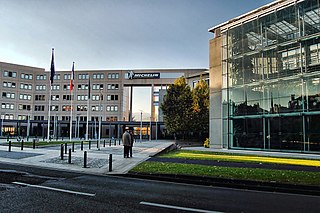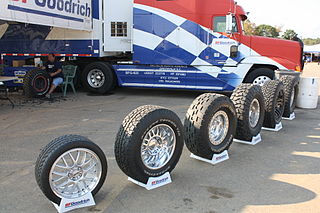Related Research Articles

A tire or tyre is a ring-shaped component that surrounds a wheel's rim to transfer a vehicle's load from the axle through the wheel to the ground and to provide traction on the surface over which the wheel travels. Most tires, such as those for automobiles and bicycles, are pneumatically inflated structures, which also provide a flexible cushion that absorbs shock as the tire rolls over rough features on the surface. Tires provide a footprint, called a contact patch, that is designed to match the weight of the vehicle with the bearing strength of the surface that it rolls over by providing a bearing pressure that will not deform the surface excessively.

Michelin, in full Compagnie Générale des Établissements Michelin SCA, is a French multinational tyre manufacturing company based in Clermont-Ferrand in the Auvergne-Rhône-Alpes région of France. It is the second largest tyre manufacturer in the world behind Bridgestone and larger than both Goodyear and Continental. In addition to the Michelin brand, it also owns the Kléber tyres company, Uniroyal-Goodrich Tire Company, SASCAR, Bookatable and Camso brands. Michelin is also notable for its Red and Green travel guides, its roadmaps, the Michelin stars that the Red Guide awards to restaurants for their cooking, and for its company mascot Bibendum, colloquially known as the Michelin Man, who is a humanoid consisting of tyres.

An inflatable is an object that can be inflated with a gas, usually with air, but hydrogen, helium, and nitrogen are also used. One of several advantages of an inflatable is that it can be stored in a small space when not inflated, since inflatables depend on the presence of a gas to maintain their size and shape. Function fulfillment per mass used compared with non-inflatable strategies is a key advantage. Stadium cushions, impact guards, vehicle wheel inner tubes, emergency air bags, and inflatable space habitats employ the inflatable principle. Inflation occurs through several strategies: pumps, ram-air, blowing, and suction.

An off-road vehicle (ORV), sometimes referred to as an off-highway vehicle (OHV), overland vehicle, or adventure vehicle, is considered to be any type of vehicle which is capable of driving off paved or gravel surfaces, such as trails and forest roads that have rough and low traction surfaces.

The Tweel is an airless tire design developed by the French tire company Michelin. Its significant advantage over pneumatic tires is that the Tweel does not use a bladder full of compressed air, and therefore cannot burst, leak pressure, or become flat. Instead, the Tweel's hub is connected to the rim via flexible polyurethane spokes which fulfil the shock-absorbing role provided by the compressed air in a traditional tire.
A beadlock or bead lock is a mechanical device that secures the bead of a tire to the wheel of a vehicle. Tires and wheels are designed so that when the tire is inflated, the tire pressure pushes the bead of the tire against the inside of the wheel rim so that the tire stays on the wheel and the two rotate together. In situations where tire pressure is insufficient to hold the bead of the tire in place, a beadlock is needed.

BFGoodrich is an American tire company. Originally part of the industrial conglomerate Goodrich Corporation, it was acquired in 1990 by the French tire maker Michelin. BFGoodrich was the first American tire manufacturer to make radial tires. It made tires for the then new Winton car from Winton Motor Carriage Company.
A run-flat tire is a pneumatic vehicle tire designed to resist the effects of deflation when punctured, allowing the vehicle to continue to be driven at reduced speeds for limited distances. First developed by tire manufacturer Michelin in the 1930s, run-flat tires were introduced to the public market in the 1980s. They have increased in popularity over time.

Pneumatic tires are manufactured according to relatively standardized processes and machinery, in around 455 tire factories in the world. With over 1 billion tires manufactured worldwide annually, the tire industry is a major consumer of natural rubber. Tire factories start with bulk raw materials such as synthetic rubber, carbon black, and chemicals and produce numerous specialized components that are assembled and cured.
A tire-pressure monitoring system (TPMS) monitors the air pressure inside the pneumatic tires on vehicles. A TPMS reports real-time tire-pressure information to the driver, using either a gauge, a pictogram display, or a simple low-pressure warning light. TPMS can be divided into two different types – direct (dTPMS) and indirect (iTPMS).

A flat tire is a deflated pneumatic tire, which can cause the rim of the wheel to ride on the tire tread or the ground potentially resulting in loss of control of the vehicle or irreparable damage to the tire. The most common cause of a flat tire is puncturing of the tire by a sharp object, such as a nail or pin, letting the air escape. Depending on the size of the puncture, the tire may deflate slowly or rapidly.

The motorcycle sport of racing includes motorcycle road racing and off-road racing, both either on circuits or open courses, and track racing. Other categories include hill climbs, drag racing and land speed record trials.

Airless tires, non-pneumatic tires (NPT), or flat-free tires are tires that are not supported by air pressure. They can be used on small vehicles such as ride-on lawn mowers and motorized golf carts. They also are used on heavy equipment required to operate on sites where risk of tire punctures is high. Tires composed of closed-cell polyurethane foam are also made for bicycles and wheelchairs.

A spare tire is an additional tire carried in a motor vehicle as a replacement for one that goes flat, has a blowout, or has another emergency. Spare tire is generally a misnomer, as almost all vehicles actually carry an entire wheel with a tire mounted on it as a spare rather than just a tire, as fitting a tire to a wheel would require a motorist to carry additional, specialized equipment. However, some spare tires are not meant to be driven long distances. Space-savers have a maximum speed of around 50 mph (80 km/h).

A bicycle tire is a tire that fits on the wheel of a bicycle or similar vehicle. These tires may also be used on tricycles, wheelchairs, and handcycles, frequently for racing. Bicycle tires provide an important source of suspension, generate the lateral forces necessary for balancing and turning, and generate the longitudinal forces necessary for propulsion and braking. Although the use of a pneumatic tire greatly reduces rolling resistance compared to the use of a rigid wheel or solid tire, the tires are still typically the second largest source, after wind resistance, of power consumption on a level road. The modern detachable pneumatic bicycle tire contributed to the popularity and eventual dominance of the safety bicycle.

The Michelin PAX is an automobile run-flat tire system that utilizes a special type of rim and tire to allow temporary use of a wheel if its tire is punctured. The core of Michelin's PAX system is the semi-rigid ring installed onto the rim using special equipment. It provides support to the tire and its sidewall to allow emergency operation at limited speed until such time as the tire can be replaced. Cars that use the system include supercars like the Bugatti Veyron EB 16.4, luxury cars like the Rolls-Royce Phantom, and more common vehicles like the Honda Odyssey and Nissan Quest.

A motorcycle tyre is the outer part of motorcycle wheel, attached to the rim, providing traction, resisting wear, absorbing surface irregularities, and allowing the motorcycle to turn via countersteering. The two tyres' contact patches are the motorcycle's connection to the ground, and so are fundamental to the motorcycle's suspension behaviour, and critically affect safety, braking, fuel economy, noise, and rider comfort.

The following outline is provided as an overview of and topical guide to tires:

An aircraft tire or tyre is designed to withstand extremely heavy loads for short durations. The number of tires required for aircraft increases with the weight of the aircraft, as the weight of the airplane needs to be distributed more evenly. Aircraft tire tread patterns are designed to facilitate stability in high crosswind conditions, to channel water away to prevent hydroplaning, and for braking effect.

An inner tube is an inflatable torus that forms the interior of some pneumatic tires. The tube is inflated with a valve stem, and fits inside of the casing of the tire. The inflated inner tube provides structural support and suspension, while the outer tire provides grip and protects the more fragile tube.
References
- 1 2 3 4 5 6 Run-Flat Mousse Tyres In Detail Motorsport.com Archived 2011-06-06 at the Wayback Machine
- ↑ Michelin Motorcycle Tyres: Bib-Mousse
- ↑ "Run-Flat Tires:A New Standard Rising - MSN Autos". Archived from the original on 2008-03-08. Retrieved 2008-01-15.
- ↑ WRC: Pirelli's gravel tyre gets 'green light'